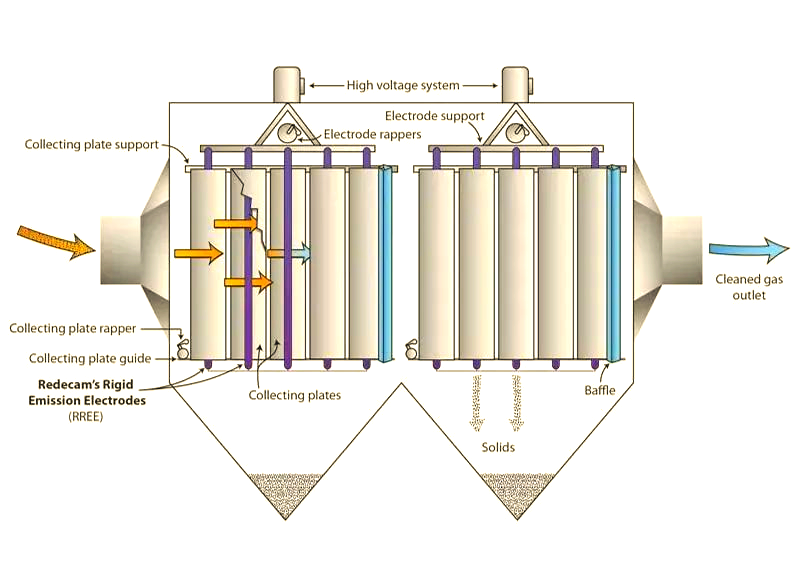A tecnologia de despoeiramento para caldeiras a carvão evoluiu desde o despoeiramento por película de água, passando pelo despoeiramento por saco até ao despoeiramento eletrostático. Com as normas ambientais cada vez mais rigorosas e a promoção e aplicação de filtros de mangas, as limitações da precipitadores electrostáticos estão a tornar-se gradualmente evidentes.
O precipitador eletrostático (ESP), que costumava ser uma referência na indústria, já não é capaz de satisfazer as exigências actuais devido aos elevados custos de manutenção, à fraca adaptabilidade aos tipos de carvão e à diminuição da eficiência. O filtro de mangas de jato pulsante, com uma eficiência de remoção de poeiras superior a 99%, custos de funcionamento mais baixos a longo prazo e vantagens de conformidade com a automatização, está a tornar-se uma melhor escolha.
Porque é que os precipitadores electrostáticos estão gradualmente a ficar obsoletos?
1. Problema de degradação da eficiência
A eficiência inicial de remoção de poeiras do 99% diminuirá devido às seguintes razões:
- Mudança do tipo de carvão (poeiras de elevada resistência específica reduzem o desempenho do ESP)
- A corrosão do elétrodo e a acumulação de poeira causam distorção do campo elétrico
- As emissões reais excedem frequentemente 100mg/m³, correndo o risco de coimas
2. O desafio do "tigre elétrico": custos de funcionamento elevados
- O consumo de energia é 3-5 vezes superior ao de um filtro de mangas (daí a alcunha de "tigre elétrico")
- A manutenção frequente, como a substituição do elétrodo, aumenta os custos de mão de obra
3. Limitações estruturais e requisitos espaciais
Necessita de uma grande área de terreno e de uma estrutura pesada em aço
Sistemas complexos de alta tensão requerem manutenção por técnicos profissionais
Vantagens técnicas do filtro de mangas
1. Excelente desempenho na remoção de poeiras
- Manutenção estável da eficiência acima de 99,5%, não afetada pela resistência específica ao pó
- Cumpre as normas GB13223, emissões ultra-baixas de Pequim e a Diretiva de Emissões Industriais da UE (IED)
2. Custos de vida mais baixos
| Fator de custo | ESPs | Armazéns |
|---|---|---|
| Investimento inicial | Elevada (custo dos ESP de 4 campos) ~20% mais) | Competitivo (em declínio devido a produção localizada de filtros) |
| Consumo de energia | 500-800 kW | 100-200 kW |
| Manutenção | Reparações frequentes dos eléctrodos | Limpeza automatizada por jato de impulsos (tempo de inatividade mínimo) |
3. Os meios filtrantes avançados prolongam a sua vida útil
Moderno PTFE-revestido, Fibra P84e membranas de nanofibras resistir:
Temperaturas elevadas (até 260°C)
Húmido e ácido gás de combustão
A vida útil do saco de filtro é de 5-7 anos, o que é muito melhor do que o ciclo de substituição de 2-3 anos dos eléctrodos ESP
Perguntas frequentes: Colectores de pó de casa de sacos
Q: Consegue lidar com gases de combustão a alta temperatura?
A: Os meios filtrantes de fibra cerâmica e malha metálica podem suportar altas temperaturas acima de 300 ℃
Q: Qual é a frequência de substituição do saco do filtro?
A: 3-5 anos com manutenção adequada (em comparação com as reparações semestrais dos ESP).
Q: É adequada uma caldeira pequena?
A: O design modular pode adaptar-se a caldeiras de várias escalas

Se precisar de saber mais sobre as soluções tecnológicas de despoeiramento para caldeiras a carvão, sinta-se à vontade para contactar-nos em qualquer altura, e dar-lhe-emos aconselhamento profissional.

